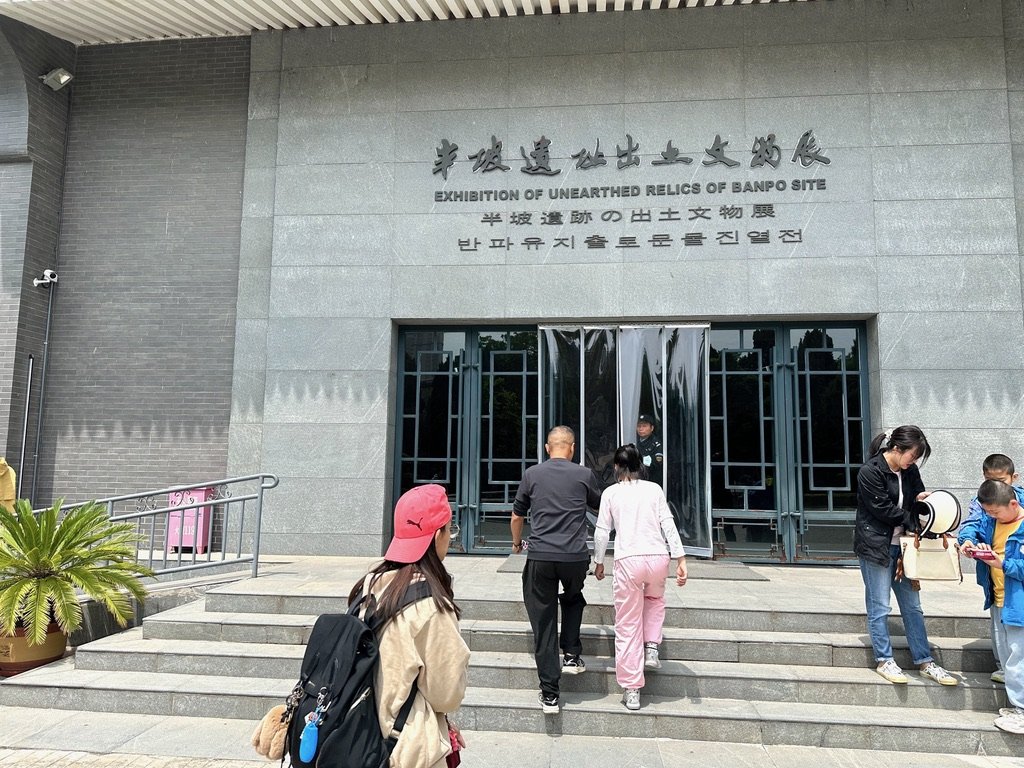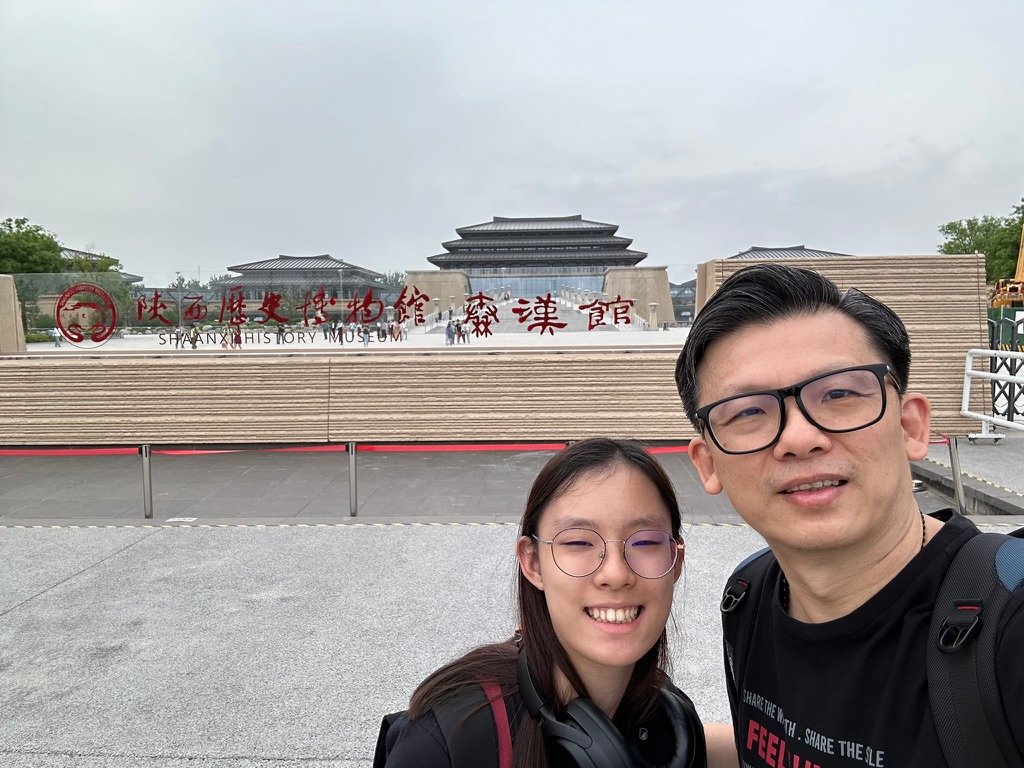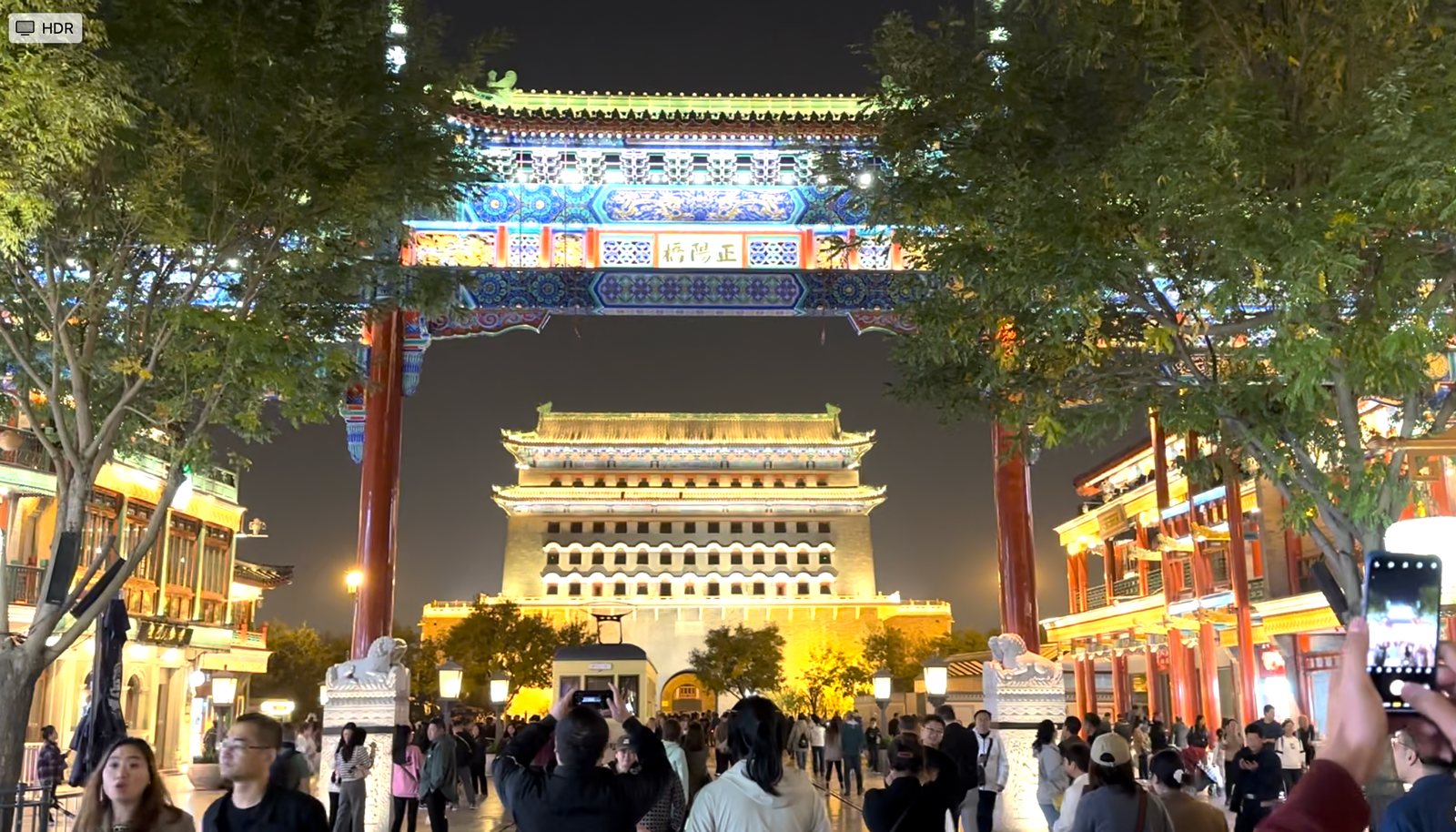The lights flickered to life just as dusk folded into night. A warm golden outline traced the rooftops of the ancient gate towers, standing proudly on the mighty Xi’an City Wall (西安城墙 Xī’ān Chéngqiáng). It was a calm evening, and as Elaine and I stepped onto the cobbled sidewalks near Yongning Gate (永宁门 Yǒngníng Mén), we felt like we had quietly walked into a painting — the kind filled with history, poetry, and gentle romance.
Xi’an (西安 Xī’ān), China’s ancient capital and the eastern gateway of the Silk Road (丝绸之路 Sīchóu zhī Lù), is no stranger to grandeur. Among the top Xi’an attractions, the city wall stands tall — not just physically, but emotionally, threading together over six centuries of stories. But it is at night, when the lanterns glow and the crowds mellow, that Xi’an shows its softer side. That’s when this city whispers its stories — not in the loud voice of tour guides or museum plaques, but in the hush of the evening air and the amber shimmer of old stones.
A Brief Walk Through Xi’an’s Dynastic Glory
Before we share more about our night, let me take you back through time.
The land we now call Xi’an (西安 Xī’ān) was once Chang’an (长安 Cháng’ān) — meaning “Perpetual Peace.” For over 1,000 years, it served as the capital for 13 Chinese dynasties.
It rose to power in the Western Zhou Dynasty (西周 Xī Zhōu, 1046–771 BCE) and gained global significance under the Han Dynasty (汉朝 Hàn Cháo, 206 BCE–220 CE), when it became the eastern terminus of the Silk Road.
During the Tang Dynasty (唐朝 Táng Cháo, 618–907), Chang’an became the largest and most cosmopolitan city in the world, influencing the capitals of Nara (Japan) and Gyeongju (Korea). Foreign monks, merchants, and scholars from as far as India, Persia, and the Middle East walked its streets.
Later, in the Ming Dynasty (明朝 Míng Cháo, 1368–1644), the rulers rebuilt the city wall — the very one that still surrounds Xi’an’s old town today.
Where Ancient Walls Meet City Pulse
Right opposite Yongning Gate, as we waited to cross the street, the view took on an almost dreamlike contrast. On one side stood the towering brick fortress — floodlit, dignified, timeless. On the other side, a modern glass-fronted building buzzed softly with warm light, filled with what looked like a mix of cafes, boutique stores, and possibly a performance venue.
As we filmed this moment, the scene felt cinematic. Motorbikes hummed gently past, streetlights cast reflections on the pavement, and locals strolled unhurriedly through the open square. The mood was mellow, but alive.
Xi’an city (西安市 Xī’ān Shì) isn’t a museum city — it’s living and breathing. And right here, next to the South Gate (南门 Nán Mén), you feel it most.

Elaine and I Cross Time — and the Road
Crossing the street with Elaine was oddly symbolic. From the modern side — sleek, urban, cosmopolitan — we stepped toward the past. But it didn’t feel like a leap. It felt like a dance. One moment we were surrounded by city lights and passing scooters; the next, we were beneath the ancient eaves of Yongning Gate (永宁门 Yǒngníng Mén), walking the same stone paths once trodden by Ming Dynasty guards.
“It’s like Trafalgar Square,” I told Elaine, “but with 600 years of Chinese history wrapped around it.”
And it really is. Yongning Gate opens up into a broad pedestrian plaza — a space where people gather, sit, take photos, or just breathe in the city’s mood. The gate’s presence is commanding, yet not overpowering. It feels safe, open, welcoming — a place made for wandering, thinking, and people-watching.
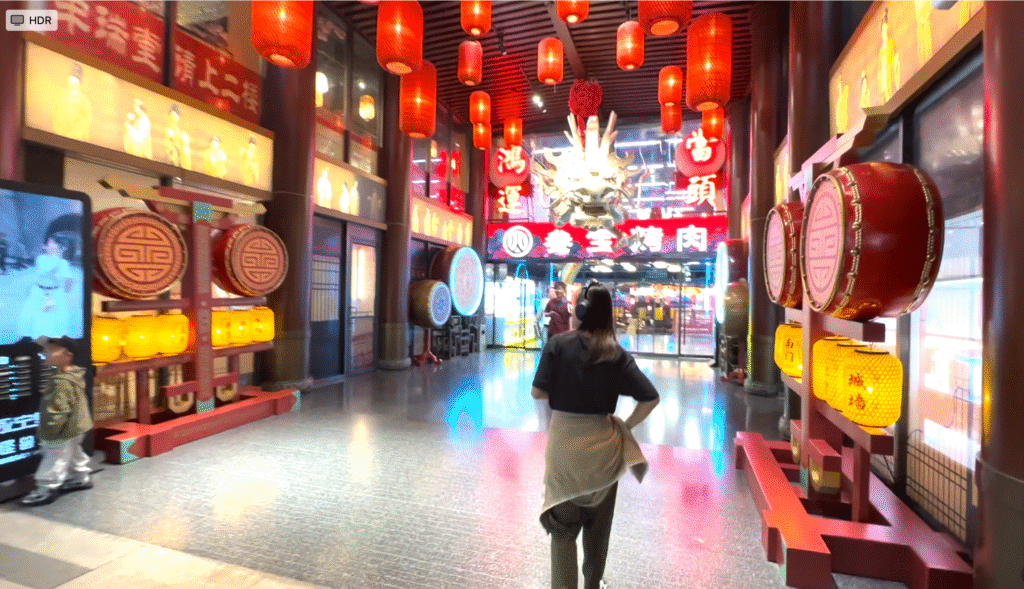
Why Western Travelers Shouldn’t Miss This Spot
If you’re planning a trip to Xi’an, China, make this area part of your evening itinerary. Here’s why:
Easy to reach: Yongning Gate is conveniently located near a metro station (Line 2, Yongningmen Station 永宁门站 Yǒngníngmén Zhàn). Or simply take a Didi (China’s version of Uber) directly there. Check the latest Xi’an metro map (西安地铁图 Xī’ān Dìtiě Tú) before you head out.
Flat and walkable: This is Xi’an’s version of a city square, open, safe, and great for families.
Picture-perfect contrast: Historic wall behind you, modern skyline in front — a dream for photographers.
Evening-friendly: Well-lit and lively at night, with locals and tourists enjoying the space late into the evening.

A Wall That Glows and Whispers
We wandered along the base of the wall, the yellow lanterns glowing beside us like gentle sentinels.
Built during the Ming Dynasty (明朝 Míng Cháo), the Xi’an City Wall stretches 13.7 kilometers, forming a massive rectangle that still encloses the ancient city center.
And here’s what many visitors don’t realize: this is the best-preserved and most complete city wall in all of China.
While other cities like Beijing or Nanjing have lost their walls to history and modern development, Xi’an’s wall survived. It was spared the wrecking ball and now stands as both a monument and a functional part of the city.
You can walk or rent a bike to circle the entire wall — it’s about a 2-hour journey that offers panoramic views of both ancient roofs inside and neon-lit boulevards outside.
The wall is 12 meters high, 12–14 meters wide at the top, and up to 18 meters thick at the base — wide enough for marching armies in the past and curious visitors today.
It wasn’t just a defense structure. It was — and still is — a symbol of order, protection, and continuity, linking imperial might with the rhythms of today’s city life.
Elaine and I sat for a moment under the shadow of the gate tower. “You can feel the stories,” she whispered. And I knew exactly what she meant.
More Than Just a Walk
This was more than just an evening walk. It was an immersive lesson in culture, time, and emotion.
For Elaine, a homeschooled, self-learning teen, travel like this is education. She wasn’t reading about history — she was touching it, hearing it in the wind, seeing it glow.
And for me, it was a reminder that the best moments in travel often come when you slow down. When you let a place speak. And Yongning Gate (永宁门 Yǒngníng Mén) speaks gently, deeply, and with dignity.
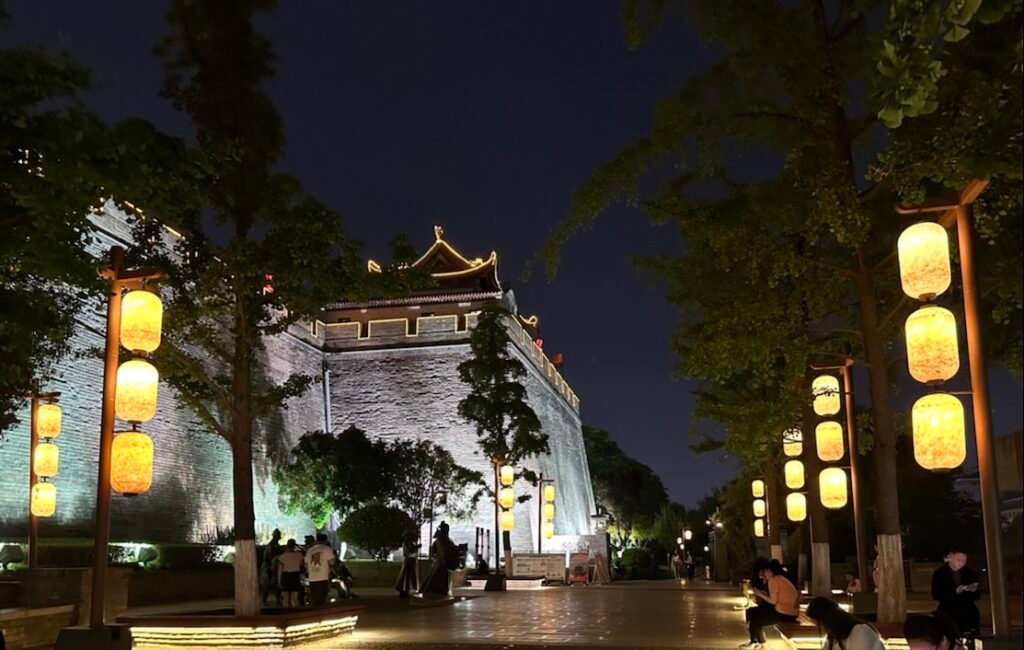
Let Xi’an Surprise You
Yes, Xi’an (西安 Xī’ān) is famous for the Terracotta Warriors (兵马俑 Bīngmǎyǒng), and they are worth the pilgrimage — you can visit their museum in Lintong (临潼 Líntóng) about an hour from the city.
But don’t stop there.
In the city itself, the Shaanxi History Museum (陕西历史博物馆 Shǎnxī Lìshǐ Bówùguǎn) showcases treasures from the Zhou (周朝 Zhōu Cháo), Qin (秦朝 Qín Cháo), Han (汉朝 Hàn Cháo), and Tang (唐朝 Táng Cháo) dynasties. It’s huge, free, and frequently packed.
The Xi’an Museum (西安博物院 Xī’ān Bówùyuàn), smaller and more intimate, focuses on the city’s role during the Tang Dynasty, and sits beside the peaceful Small Wild Goose Pagoda (小雁塔 Xiǎo Yàntǎ).
Looking for flavor? Head to the Xi’an Muslim Quarter (回民街 Huímín Jiē), a bustling paradise of skewers, flatbreads, and hand-pulled noodles.
Use a Xi’an China map or Xi’an map to plan your route, and if you’re arriving through Xian Xianyang Airport (西安咸阳国际机场 Xī’ān Xiányáng Guójì Jīchǎng), head straight into the heart of the city. Whether you’re staying in a cozy Xi’an hotel (西安酒店 Xī’ān Jiǔdiàn) or exploring for a day, start with the wall.
So take that stroll. Slow down. Start at Yongning Gate. Let the city show you who she really is — timeless, evolving, and endlessly charming.


